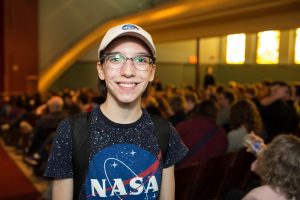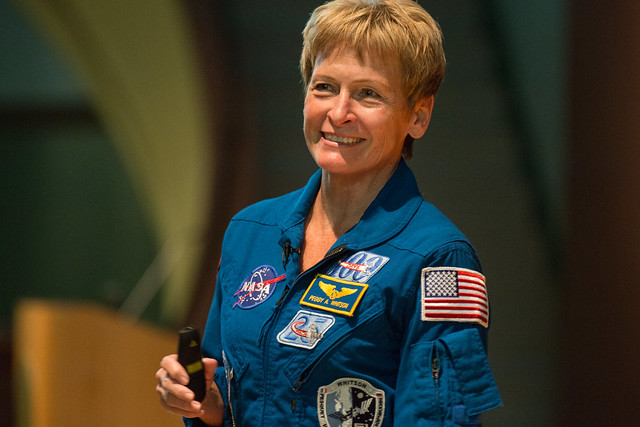“Gravity sucks”! said Peggy Whitson, and she should know.
The Iowa girl who grew up on a farm near Mount Ayr to become a biochemist/astronaut has logged 665 days in outer space, the U.S. record, and she gave a whole new perspective on the notion of homesickness during an appearance at Sheslow Auditorium on the campus of Drake University Friday afternoon.
Dr. Whitson was in town to receive Drake’s 2018 Robert D. Ray Pillar of Character Award, and before the big banquet in her honor Friday night she showed up in her snappy NASA jumpsuit to enthrall an audience of students from all over central Iowa. Included was a contingent of about 60 students from Central Campus and Central Academy.
The Central Campus group was from the school’s aviation and cybersecurity programs (One of the aviation students is 70 years old according to Gretchen Watznauer, the CC Coordinator for Student Leadership and Engagement. He may be a story for another time, all by himself). The Central Academy bunch responded to school director Jessica Gogerty’s assignment to write a paragraph about why they wanted to attend.
Whitson didn’t disappoint. She’s a down-to-earth woman with a compelling story to share about life among the stars who seasons her scientific travelogue with a lively sense of humor. Besides captivating shots of Mother Earth, the Milky Way, aurora borealis and solar eclipses shot from the vantage point of the International Space Station, her presentation was leavened with clips of Whitson and her crewmates gulping floating globs of Jello out of midair, like frogs catching flies. When someone asked what it feels like to blastoff at the top of a rocket she described it this way: “When the solid rocket boosters on the space shuttle engage…let’s just say when those suckers fire up, you know you’re going somewhere.”
At the dizzying velocity of 17,500 MPH, no less! One orbit every 90 minutes, which means a sunrise or a sunset about every 45.
The hundreds of experiments she performed during her three long stints aboard the ISS, which is the size of a football field and was assembled module by module while in Earth orbit, included growing soybeans, just like she used to back on the farm. She’s also a veteran of 10 EVAs (spacewalks). Farmers need to be good troubleshooters and so do astronauts. Whitson came in handy when minor repairs were called for on the ISS. You don’t have to worry about misplacing your screwdriver or wrench when they’re tethered to your spacesuit, but they can be hard to handle in gloves the size of a hockey goalie’s.
Fifteen nations collaborate on the space station that’s been going around and around in circles for 18 years now. Russia is one of them and Whitson said that, “Learning Russian is the hardest thing I’ve had to do in becoming an astronaut.”
The best thing?
“Floating is amazing (in zero gravity). Everything here on Earth is dictated by gravity. But up there, heck, you can walk on the ceiling.”
Roosevelt 10th grader Lydia Kling sported a NASA cap and T-shirt for the event. Yes, she said, she does have astronautic ambitions. When another questioner wondered what obstacles Whitson encountered in her career because of her gender, Kling took particular interest in the response.
“Barriers were removed before I came along,” said America’s grand dame of space flight. “I just always figured my job was to prove myself capable. Don’t carry around a chip on your shoulder because it’ll get heavy. Just work hard to be the best.”
Oh, about the homesickness…
“Some astronauts get sick going up and some get sick coming down,” Whitson said. She’s one of the latter type. “When you’ve been weightless for a long time (as she has for what amounts to almost two full years of her life), it takes a while to reteach a lot of your little muscles about balance and things like that. There’s definitely some puking involved.”
Thanks for sharing.







